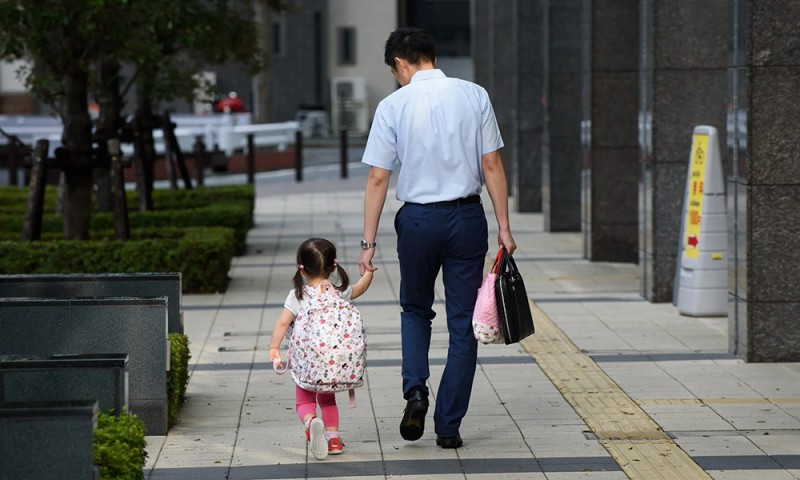
日本正面临人口危机,其最大城市东京将尝试实施创新举措解决问题:推行每周四天工作制。
作为日本最大雇主之一,东京都政府自今年4月起,允许员工每周仅工作四天。同时新增“育儿部分休假”政策,部分员工每日可减少两小时工作时间。东京都知事小池百合子(Yuriko Koike)表示,此举旨在帮助育儿员工平衡育儿与工作。
据《日本时报》报道,小池百合子在2024年12月东京都议会例行会议的演讲中表示:“我们将继续灵活调整工作模式,确保女性不必因生育、育儿等人生重大事件而牺牲事业。”
新政策出台之际,日本上半年出生率创历史新低。据日本厚生劳动省统计,1月至6月,新生儿数量为33.928万,较去年同期减少约1万。
日本并非唯一面临生育率下滑困境的国家。《纽约客》指出,预计到2100年,全球97%的国家生育率将低于“人口替代水平”(即维持人口稳定所需的生育数量)。韩国是全球生育率最低的国家,2023年该国宠物狗推车销量超过婴儿推车。尽管联合国预测本世纪很长一段时间内全球人口将持续增长,但部分“鼓励生育者”(其中最受关注的是全球首富、育有13个子女的埃隆·马斯克(Elon Musk))担忧,生育率下降将成为全球即将面临的最严峻挑战之一。
2023年,日本总和生育率(即一名女性一生生育子女数量)为1.2,东京生育率更低,为0.99。经济合作与发展组织(OECD)指出,要维持人口基本稳定,生育率需达到2.1。美国中央情报局(CIA)数据显示,日本公民的年龄中位数为49.9岁,而美国为38.9岁。
为扭转低生育率局面,日本已采取一系列激进措施。自20世纪90年代起,日本政府要求企业提供充足的育儿假、增加托育补贴,并开始向父母发放现金补贴。今年早些时候,东京政府还推出专属交友应用,帮助单身人士寻找伴侣、步入婚姻。
然而,政府数据显示,过去八年间日本出生率仍持续下滑。
推行每周四天工作制或有助于解决日本高强度工作文化引发的部分核心问题,这种文化对职业女性的影响尤为突出。国际货币基金组织(IMF)数据显示,在经济合作与发展组织成员国中,日本男女家务劳动时间差距最大:女性承担的育儿、养老等无偿劳动时长,是男性的五倍。
该机构的调查显示,超半数实际生育子女数低于预期的女性表示,不愿多生育的原因在于再添一孩将大幅增加家务负担。
在部分案例中,推行四天工作制已被证实能改善家务分配公平性。倡导该制度的组织“全球四天工作制”(4 Day Week Global)曾在六个国家开展试验,结果显示,实行四天工作制后,男性投入育儿的时间增加了22%,家务劳动时间增加了23%。
房地产服务公司仲量联行(JLL)全球未来工作负责人彼得·米斯科维奇(Peter Miscovich)表示,四天工作制要实现广泛普及,需经历重大社会变革,但多年试验表明,每周少工作一天能提升员工生产力与幸福感。
米斯科维奇向《财富》杂志透露:“由此带来的积极影响包括:员工压力减轻、职业倦怠降低、休息质量提高、睡眠状况改善、个人开支降低、工作时段专注度提升,在某些情况下甚至增强了员工对企业的忠诚度。”
职场咨询机构Workathon创始人、《工作假设:新冠疫情与生成式人工智能时代前后的职场认知变迁》一书的作者朱莉娅·霍布斯鲍姆(Julia Hobsbawm)指出,尽管东京等地的四天工作制试点具有创新性,但或许并非如某些人宣称的那样是“万能解决方案”。
“我坚信不存在万能解决方案。”霍布斯鲍姆向《财富》杂志表示。
“当前工作模式在技术与人力层面的灵活性持续提升,绝不能断言:某一国家、某一行业、某一目的适用的四天工作制能放之四海而皆准。”(*)
译者:中慧言-王芳
日本正面临人口危机,其最大城市东京将尝试实施创新举措解决问题:推行每周四天工作制。
作为日本最大雇主之一,东京都政府自今年4月起,允许员工每周仅工作四天。同时新增“育儿部分休假”政策,部分员工每日可减少两小时工作时间。东京都知事小池百合子(Yuriko Koike)表示,此举旨在帮助育儿员工平衡育儿与工作。
据《日本时报》报道,小池百合子在2024年12月东京都议会例行会议的演讲中表示:“我们将继续灵活调整工作模式,确保女性不必因生育、育儿等人生重大事件而牺牲事业。”
新政策出台之际,日本上半年出生率创历史新低。据日本厚生劳动省统计,1月至6月,新生儿数量为33.928万,较去年同期减少约1万。
日本并非唯一面临生育率下滑困境的国家。《纽约客》指出,预计到2100年,全球97%的国家生育率将低于“人口替代水平”(即维持人口稳定所需的生育数量)。韩国是全球生育率最低的国家,2023年该国宠物狗推车销量超过婴儿推车。尽管联合国预测本世纪很长一段时间内全球人口将持续增长,但部分“鼓励生育者”(其中最受关注的是全球首富、育有13个子女的埃隆·马斯克(Elon Musk))担忧,生育率下降将成为全球即将面临的最严峻挑战之一。
2023年,日本总和生育率(即一名女性一生生育子女数量)为1.2,东京生育率更低,为0.99。经济合作与发展组织(OECD)指出,要维持人口基本稳定,生育率需达到2.1。美国中央情报局(CIA)数据显示,日本公民的年龄中位数为49.9岁,而美国为38.9岁。
为扭转低生育率局面,日本已采取一系列激进措施。自20世纪90年代起,日本政府要求企业提供充足的育儿假、增加托育补贴,并开始向父母发放现金补贴。今年早些时候,东京政府还推出专属交友应用,帮助单身人士寻找伴侣、步入婚姻。
然而,政府数据显示,过去八年间日本出生率仍持续下滑。
推行每周四天工作制或有助于解决日本高强度工作文化引发的部分核心问题,这种文化对职业女性的影响尤为突出。国际货币基金组织(IMF)数据显示,在经济合作与发展组织成员国中,日本男女家务劳动时间差距最大:女性承担的育儿、养老等无偿劳动时长,是男性的五倍。
该机构的调查显示,超半数实际生育子女数低于预期的女性表示,不愿多生育的原因在于再添一孩将大幅增加家务负担。
在部分案例中,推行四天工作制已被证实能改善家务分配公平性。倡导该制度的组织“全球四天工作制”(4 Day Week Global)曾在六个国家开展试验,结果显示,实行四天工作制后,男性投入育儿的时间增加了22%,家务劳动时间增加了23%。
房地产服务公司仲量联行(JLL)全球未来工作负责人彼得·米斯科维奇(Peter Miscovich)表示,四天工作制要实现广泛普及,需经历重大社会变革,但多年试验表明,每周少工作一天能提升员工生产力与幸福感。
米斯科维奇向《财富》杂志透露:“由此带来的积极影响包括:员工压力减轻、职业倦怠降低、休息质量提高、睡眠状况改善、个人开支降低、工作时段专注度提升,在某些情况下甚至增强了员工对企业的忠诚度。”
职场咨询机构Workathon创始人、《工作假设:新冠疫情与生成式人工智能时代前后的职场认知变迁》一书的作者朱莉娅·霍布斯鲍姆(Julia Hobsbawm)指出,尽管东京等地的四天工作制试点具有创新性,但或许并非如某些人宣称的那样是“万能解决方案”。
“我坚信不存在万能解决方案。”霍布斯鲍姆向《财富》杂志表示。
“当前工作模式在技术与人力层面的灵活性持续提升,绝不能断言:某一国家、某一行业、某一目的适用的四天工作制能放之四海而皆准。”(*)
译者:中慧言-王芳
Japan is facing a population crisis—so Tokyo, its largest city, will try to solve the problem with something new: a four-day workweek.
Starting in April this year, the Tokyo Metropolitan government, one of the country’s largest employers, started to allow its employees to work only four days a week. It is also adding a new “childcare partial leave” policy, which will allow some employees to work two fewer hours per day. The goal is to help employees who are parents balance childcare and work, said Tokyo Governor Yuriko Koike.
“We will continue to review work styles flexibly to ensure that women do not have to sacrifice their careers due to life events such as childbirth or child-rearing,” Koike said in a speech during the Tokyo Metropolitan Assembly’s regular session in December 2024, the Japan Times reported.
The new policies come as the birth rate in Japan hit a record low for the first half of the year. From January to June, the country recorded 339,280 births, around 10,000 fewer births than during the same period last year, according to the Ministry of Health, Labor, and Welfare.
Japan isn’t the only country facing declining fertility. According to the New Yorker, by 2100, 97% of the world’s countries are predicted to be below replacement, or the number of births required to maintain a stable population. South Korea has the lowest fertility rate in the world, and dog strollers outsold baby strollers there in 2023. While the United Nations predicts the global population will continue to grow long into this century, some pro-natalists (including, notably, the world’s richest man and father of 13 Elon Musk) worry declining birth rates are the world’s biggest looming problem.
Japan’s total fertility rate, which represents the number of children a woman has in her lifetime, stood at 1.2 in 2023, and in Tokyo, the birth rate was even lower at 0.99. To maintain a broadly stable population, a birth rate of 2.1 is required, according to the Organisation for Economic Co-operation and Development (OECD). The median age of a Japanese citizen is 49.9, according to the Central Intelligence Agency. In the U.S., the median age is 38.9.
Japan has taken drastic steps toward reversing its low birth rate. Starting in the 1990s, the government required companies to offer generous parental leave, added subsidies for day care, and started offering cash payments to parents. Earlier this year, the Tokyo government also launched its own dating app to help single people find a partner and marry.
Yet the birth rate has still fallen consistently over the past eight years, according to government data.
Moving to a four-day workweek could help address some of the core issues associated with Japan’s heavy work culture, which can especially weigh on working women. The gap between men and women when it comes to housework is one of the largest among OECD countries, with women in Japan engaging in five times more unpaid work, such as childcare and elder care, than men, according to the International Monetary Fund.
More than half of women who had fewer children than they would have preferred said they had fewer children because of the increased housework that another child would bring, according to the IMF.
In some cases, moving to a four-day workweek has been shown to improve housework equity. Men reported spending 22% more time on childcare and 23% more time on housework during a four-day workweek trial conducted across six countries by 4 Day Week Global, which advocates for the issue.
It would take a major societal change for the four-day workweek to catch on more broadly, but years of experiments have shown that working one day less a week improves employee productivity and well-being, said Peter Miscovich, the global future of work leader at real estate services company JLL.
“The upside from all of that has been less stress, less burnout, better rest, better sleep, less cost to the employee, higher levels of focus and concentration during the working hours, and in some cases, greater commitment to the organization as a result,” Miscovich told Fortune.
While four-day workweek tests like the one in Tokyo can be innovative experiments, they may not be the solution that some make them out to be, said Julia Hobsbawm, the founder of workplace consultancy Workathon and author of the book Working Assumptions: What We Thought We Knew About Work Before Covid and Generative AI—And What We Know Now.
“I firmly believe that there is no one-size-fits-all,” Hobsbawm told Fortune.
“In a time of increasing flexibility across working practices, both technological and human, you simply can’t say that the one size that might fit one industry, in one country, for one purpose, of a four-day week fits all.”

